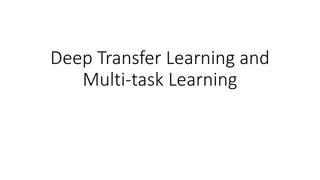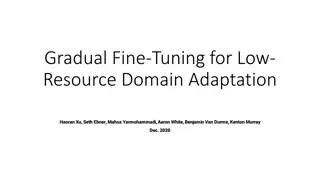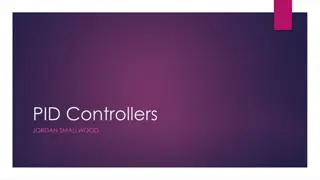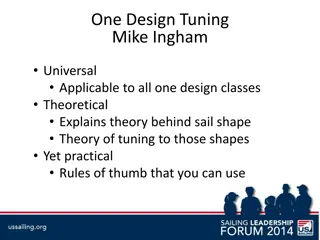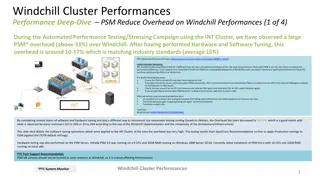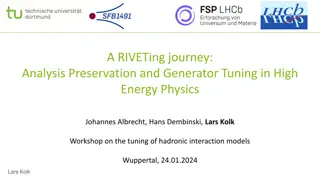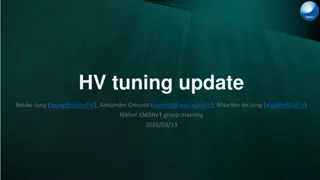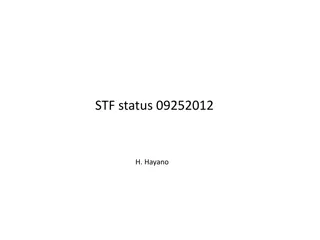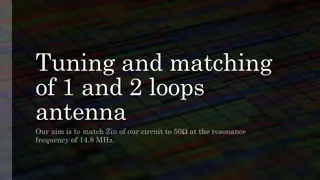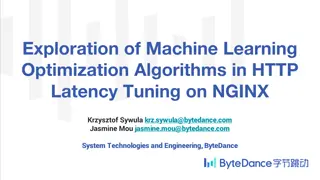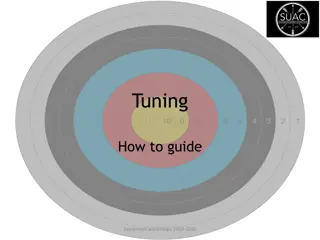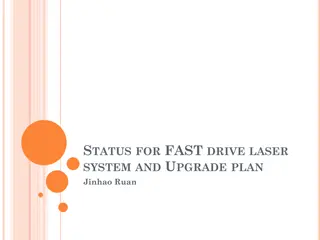
Tuning Methods and Model Identification for PID Controllers
Explore different tuning methods such as Ziegler-Nichols and Tyreus-Luyben, model identification tests like open-loop and closed-loop tests, and information on autotuning of PID controllers. Discover suitable tuning rules based on process characteristics and learn about PID tuning based on Internal Model Control (IMC). Delve into recommended approaches for different types of processes and gain insights into model identification through step tests.
Download Presentation

Please find below an Image/Link to download the presentation.
The content on the website is provided AS IS for your information and personal use only. It may not be sold, licensed, or shared on other websites without obtaining consent from the author. If you encounter any issues during the download, it is possible that the publisher has removed the file from their server.
You are allowed to download the files provided on this website for personal or commercial use, subject to the condition that they are used lawfully. All files are the property of their respective owners.
The content on the website is provided AS IS for your information and personal use only. It may not be sold, licensed, or shared on other websites without obtaining consent from the author.
E N D
Presentation Transcript
PID Tuning Tuning of PID Controllers 1- Tuning methods (Ziegler-Nichols, Tyreus-Luyben, Ciancone-Marlin, IMC) 2- Model identification tests (Open loop tests, Closed loop tests) Ref: C. C. Yu, Autotuning of PID controllers, 2nded., springer, 2006. Chapters 2, 3 & 4 Lecturer: M. A. Fanaei Ferdowsi University of Mashhad
Tuning Methods of PID Controllers About 250 tuning rules are exist for PI and PID Controllers What is the suitable tuning rule? It really depends on your process (Type, Order, Parameters, Nonlinearity, Uncertainty, etc) Ds K e Ziegler-Nichols(1942): Recommended for 0.1< D/ <0.5 ( ) p + 1 s 2
Tuning Methods of PID Controllers Tyreus-Luyben(1992): Recommended for time-constant dominant processes ( D/ <0. 1 ) Ciancone-Marlin(1992): Recommended for dead-time dominant processes ( D/ .0 ) 3
Tuning Methods of PID Controllers PID tuning based on IMC (Rivera et al., 1986) I Kc Method min SIMC D + ( ) Kp D +D) 4( + + / 3 D D / 3 D min ISIMC D + + ( ) K 4( D) 4 p
Model Identification (Open-loop step test) Step Change Record Final Control Element Sensor/ Transmitter Process m(t), % c(t) , % : first order plus dead time Ds K e ( ) C s p = + ( ) 1 M s s Process Gain: c = s K p m 5
Model Identification (Open-loop step test) Fit 1 : D = 0t 6
Model Identification (Open-loop step test) Fit 2 : D = 0t 7
Model Identification (Open-loop step test) 3 Fit 3 : = = ( ) , t t D t 2 1 2 2 8
Model Identification (Close-loop ZN) Ziegler-Nichols Test (1942) 1. Set the controller gain Kcat a low value, perhaps 0.2. 2. Put the controller in the automatic mode. 3. Make a small change in the set point or load variable and observe the response. If the gain is low, then the response will be sluggish. 4. Increase the gain by a factor of two and make another set point or load change. 5. Repeat step 4 until the loop becomes oscillatory and continuous cycling is observed. The gain at which this occurs is the ultimate gain Kcu , and the period of oscillation is the ultimate period Pu. 9
Model Identification (Relay feedback test) Relay Feedback Test (Astrom & Hagglund, 1984) Luyben popularized relay feedback method and called this method ATV (autotune variation). 10
Model Identification (Relay feedback test) 5 . 1 e is the noise bound 4 h Kcu a 11
Model Identification (Relay feedback test) Advantages of Relay Feedback Test 1. It identifies process information around the important frequency, the ultimate frequency (where the phase angle is - ). 2. It is a closed-loop test; therefore, the process will not drift away from the nominal operating point. 3. The amplitude of oscillation is under control (by adjusting h ). 4. The time required for a relay feedback test is roughly equal to two to four times the ultimate period. If the normalized dead time D/ is less than 0.28, the ultimate period is smaller than the process time constant. Therefore the relay feedback test is more time efficient than the step test. Since the dead time can not be too large, the temperature and composition loops in process industries seem to fall into this category. 5. 12
Model Identification (Relay feedback test) Ds K e Advantages of Relay Feedback Test p + 1 s 13
Model Identification (Relay feedback test) Process model identification from a Relay Feedback Test In theory, the steady state gain can be obtained from plant data (Kp = y/ u).For highly nonlinear process, the change in input ( u) must be small as 10-3 to 10-6 % of the full range. Therefore for highly nonlinear processes, trying to obtain reliable steady state gains from plant data is usually impractical. Luyben showed that the simple relay feedback test provides an effective way to determine the linear model for such processes. If necessary, the dead time (D) in the transfer function can be easily read off from the initial part of the relay feedback test. 14
Model Identification (Relay feedback test) Process model identification from a Relay Feedback Test e K p Ds Model 1 (FOPDT) : + 1 s = = + 1 2 tan ( ) , / ( ) 1 D AR K p = = + 1 2 tan ( ) , ( ) 1 D K K u u cu p u tan( ) D = u u 2+ ( ) 1 = u K p K cu 15
Model Identification (Relay feedback test) Ds K e p Model 2 (integrator plus dead time) : s = = = / 2 , / D AR K p = = , u D K p = 2 / 2 , D K K K u cu p u u cu Ds K pe Model 3 (pure dead time): = = , D AR K 1 p = = , D K p = = , 1 D K K K u cu p u cu 16
Model Identification (Relay feedback test) If a FOPDT model can not be identified ( <0 is resulted) then one can try to identify a SOPDT model. Ds K e p Model 4 (SOPDT) : 2) 1 + ( s = = ) 1 + 1 2 2 tan ( , ) /(( ) D AR K p = = + 1 2 2 tan ( ) , ( ) 1 D K K u u cu p u tan(( / ) ) 2 D = u u 2+ ( ) 1 = u K p K 17 cu
Model Identification (Relay feedback test) Relay feedback responses of FOPDT processes Assume an integrator plus dead time (Time constant dominant processes) Assume a FOPDT (Most slow processes) Assume a pure dead time (Dead time dominant processes) 18
Model Identification (Close-loop step test) Shamsuzzoha and Skogestad, 2010 Yuwana and Seborg, 1982, proposed a modification to the Ziegler-Nichols closed-loop experiment. Instead of bringing the system to its limit of stability, one uses a P-controller with a gain that is about half this value, such that the resulting overshoot to a step change in the setpoint is about 30%.This method was modified by Shamsuzzoha and Skogestad, 2010. 19
Model Identification (Close-loop step test) Kc : Controller gain used in experiment ys : Set point change tp : First peak time yp : Maximum output change y : Steady state output change 1 y y y y = y y K p = = , s p OV B K B c ( . 0 ) = + . 0 61 r 309 . 0 209 D e t p . 1 = . 1 + 2 152 607 1 A OV OV = r D = 2 / r A B 20

